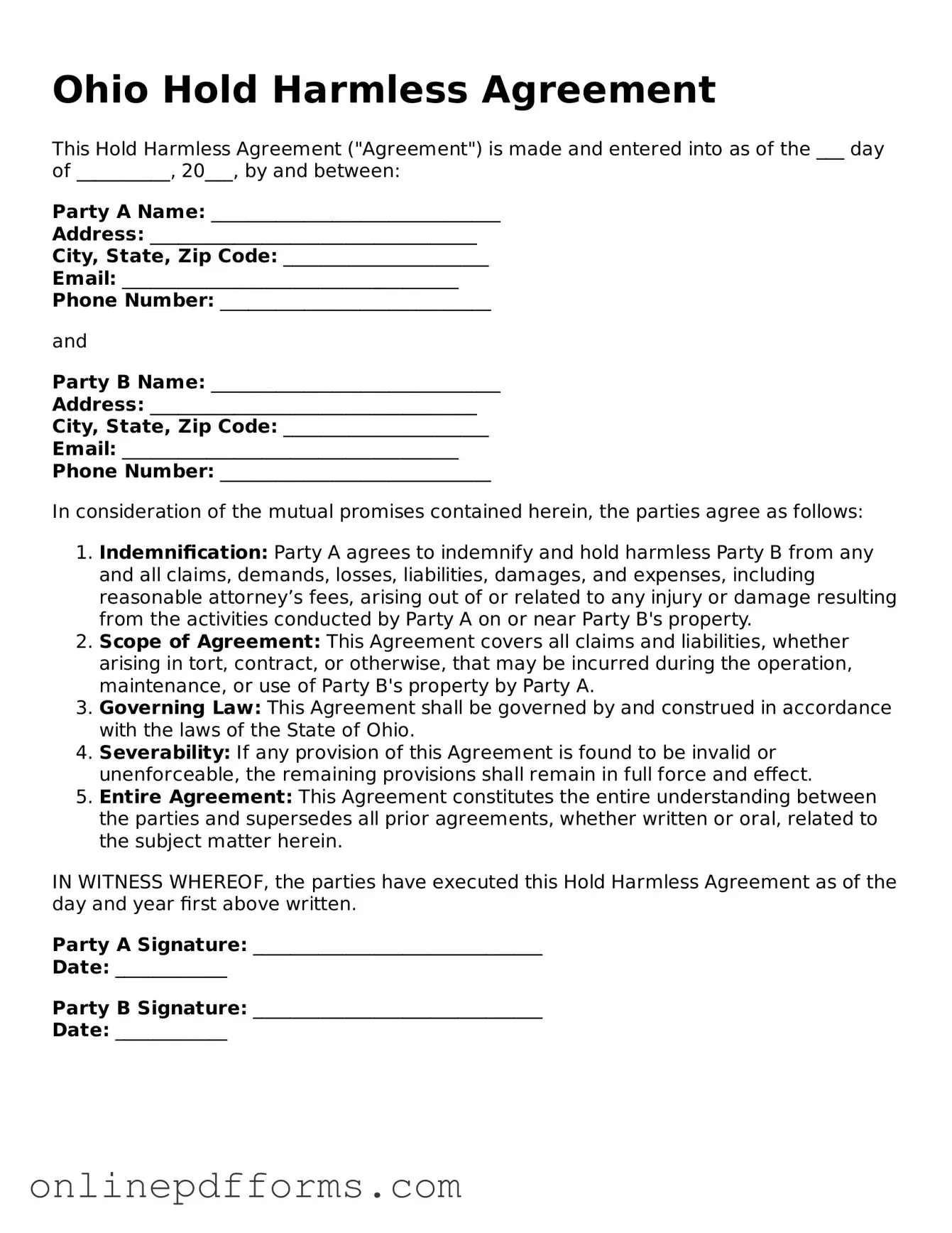The Waiver of Liability is a document that shares similarities with the Ohio Hold Harmless Agreement. Both forms aim to protect one party from legal claims arising from the actions or negligence of another. In a Waiver of Liability, individuals often agree to relinquish their right to sue for injuries sustained during an event or activity. This is particularly common in recreational settings, where participants acknowledge the risks involved and agree not to hold the organizers responsible for any injuries that may occur.
The Indemnity Agreement is another document that functions similarly to the Hold Harmless Agreement. Indemnity Agreements are designed to allocate risk between parties, where one party agrees to compensate the other for any losses or damages that arise from specific activities or events. Like the Hold Harmless Agreement, it seeks to protect one party from financial repercussions due to the actions of another, thereby providing a layer of financial security.
The Release of Claims form is also comparable to the Ohio Hold Harmless Agreement. This document allows individuals to release another party from liability for any claims or damages that may arise from a specific activity. By signing a Release of Claims, individuals acknowledge the risks involved and agree not to pursue legal action against the party being released, similar to the protections offered in a Hold Harmless Agreement.
The Liability Insurance Waiver is a document that aligns closely with the Hold Harmless Agreement. When individuals sign a Liability Insurance Waiver, they agree to waive their right to seek damages from the entity providing the waiver, often in exchange for participation in an activity. This waiver serves to protect the entity from legal claims, similar to how a Hold Harmless Agreement functions to shield one party from liability.
The Participant Agreement is another document that bears resemblance to the Ohio Hold Harmless Agreement. This agreement is often used in organized activities, such as sports or workshops, where participants acknowledge the inherent risks involved. By signing a Participant Agreement, individuals agree to hold the organizers harmless from any injuries or damages, mirroring the intent of the Hold Harmless Agreement.
The Consent Form is similar in that it often includes a waiver of liability component. Participants typically sign consent forms to indicate their understanding of the risks associated with an activity. By doing so, they may also agree not to hold the organizers liable for any injuries, which is a key feature of the Hold Harmless Agreement.
The Safety Agreement is another document that shares characteristics with the Hold Harmless Agreement. This type of agreement is often used in environments where safety is a primary concern. Participants acknowledge the risks involved in certain activities and agree to follow safety protocols. In doing so, they may also agree to hold the organization harmless from any injuries that occur, similar to the intent behind a Hold Harmless Agreement.
The Contractor Agreement often includes hold harmless provisions that protect one party from liability arising from the actions of the other. In construction or service contexts, these agreements specify that the contractor will indemnify the property owner for any claims resulting from the contractor's work. This is akin to the Hold Harmless Agreement, which seeks to limit liability for one party.
The Event Agreement is another document that may contain hold harmless clauses. When organizing events, planners often require participants to sign an Event Agreement that includes language protecting the organizers from liability for injuries sustained during the event. This serves a similar purpose to the Hold Harmless Agreement, ensuring that organizers are not held financially responsible for unforeseen incidents.
Finally, the Non-Disclosure Agreement (NDA) may also contain elements that resemble the Hold Harmless Agreement. While NDAs primarily focus on protecting confidential information, they can include clauses that limit liability for disclosures made in good faith. This aspect echoes the protective nature of the Hold Harmless Agreement, as both documents aim to shield one party from potential repercussions.
